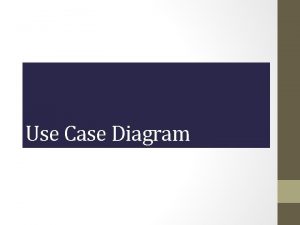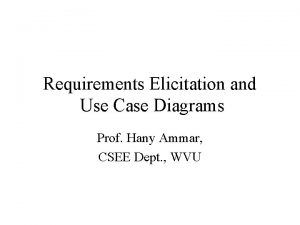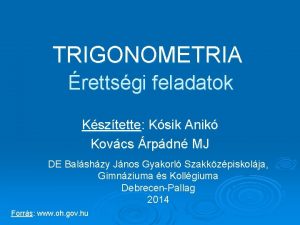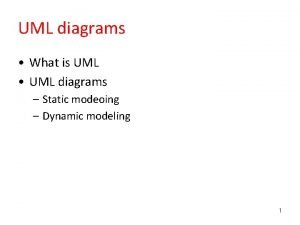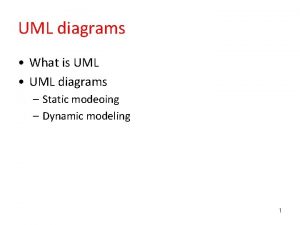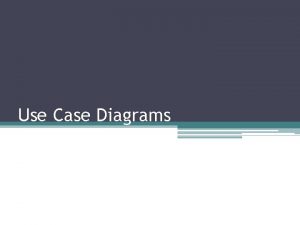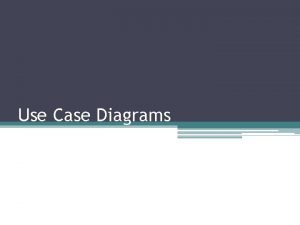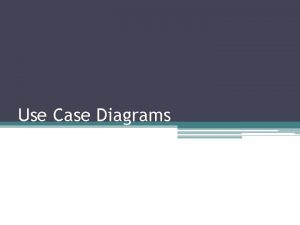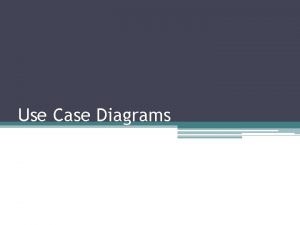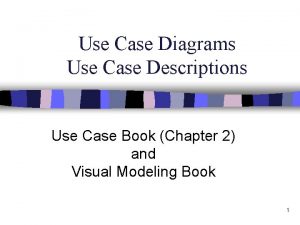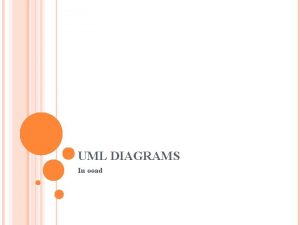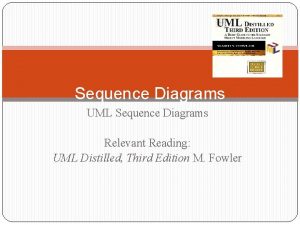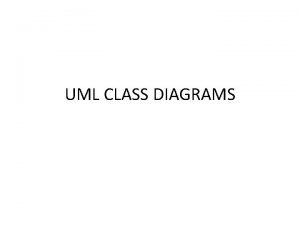UML Diagrams Use Case Diagrams Prof Hany Ammar


















- Slides: 18

UML Diagrams: Use Case Diagrams Prof. Hany Ammar, CSEE Dept. , WVU

Use Case Diagrams • Use cases are widely regarded as one of the most critical artifacts needed to successfully develop complex software systems • Use cases define the scope of the system and clarify the behavioral system requirements

Use Case Diagrams • Provide a basis for a coherent conceptual understanding of the system under consideration without requiring knowledge of software design or implementation technology • Used as organized means of capturing domain expertise

Use Case Diagrams • Can be used to track the progress of the system development effort • Provide means to trace requirements to the design • Provide the basis for developing system acceptance tests

Use Case Diagrams • The identification of use cases and actors occurs during the initial requirements analysis phase of a project • The use cases most essential to the system are selected, analyzed, and specified.

Use Case Diagrams • These essential use cases eventually become the basis for defining the architecture of the system during the first iterations of system development • The use cases are then allocated to iterative releases, which are planned and eventually executed

Use Case Diagrams • In the requirements phase of each delivery, the use cases allocated to that delivery are analyzed and completely specified • the use cases would then be realized by domain level analysis/design using class and interaction diagrams

Use Case Diagrams • The domain level realization is further refined into a detailed design that typically employs class and interaction diagrams and often includes state transition diagrams and/or decision tables.

Use Case Diagrams Use Case Diagram Rules – Use a “stick man” figure for an actor, and show the actor’s name below the stick man – The UML standard allows for the option of using a class rectangle with the stereotype «actor» Sensor

Use Case Diagrams • The only valid relationship between an actor and another actor is generalization

Use Case Diagrams • Use only the following relationships between use cases – Use the include relationship to show that the behavior of one use case is wholly and unconditionally used in another use case – Use the generalization relationship to show that a use case is a specialization of another use case

Use Case Diagrams • the include relationship

Use Case Diagrams • the generalization relationship

Use Case Diagrams • Use the extend relationship to show that one use case conditionally augments the behavior of another use case.

Use Case Diagrams • Extension points for a base use case are identified within the specification of that base use case • These are the locations where another use case may extend the base use case. These extension points are optionally shown in a diagram by listing them in a compartment of the base use case bubble under the heading “extension points • The extending relationship identifies, within parenthesis, the extension point(s) in the use case being extended

Use Case Diagrams • There must be one extension point listed for each segment identified in the extension use case • Although considered optional, it is recommended that the extending relationship also identify, within brackets, the condition under which the extension is executed

Use Case Diagrams • Use cases are often written and organized in layers of abstractions using Use Case Packages • A use case package contains a number of actors, use cases, their relationships, and other packages A Use Case Package

Example: Air Traffic Control System
 Hany ammar
Hany ammar Hany ammar
Hany ammar Hany ammar
Hany ammar The interaction diagrams, use case diagrams are called as
The interaction diagrams, use case diagrams are called as Uml use case visio
Uml use case visio Include and extend in use case
Include and extend in use case Use case diagram rules
Use case diagram rules Wafaa pronunciation
Wafaa pronunciation Ammar yaseen
Ammar yaseen Dr ammar attiya
Dr ammar attiya Zookeeper ammar
Zookeeper ammar Ammar mirascija
Ammar mirascija Waleed ammar
Waleed ammar How do you spell colleague
How do you spell colleague Best case worst case average case
Best case worst case average case Uml 0..*
Uml 0..* Sinus feladatok
Sinus feladatok Rfolyam
Rfolyam Hány szó van a magyar nyelvben
Hány szó van a magyar nyelvben





